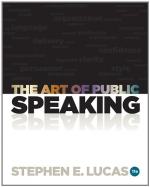Effective speech must reflect the era. This is not a rose water age, and a tepid, half-hearted speech will not win. This is the century of trip hammers, of overland expresses that dash under cities and through mountain tunnels, and you must instill this spirit into your speech if you would move a popular audience. From a front seat listen to a first-class company present a modern Broadway drama—not a comedy, but a gripping, thrilling drama. Do not become absorbed in the story; reserve all your attention for the technique and the force of the acting. There is a kick and a crash as well as an infinitely subtle intensity in the big, climax-speeches that suggest this lesson: the same well-calculated, restrained, delicately shaded force would simply rivet your ideas in the minds of your audience. An air-gun will rattle bird-shot against a window pane—it takes a rifle to wing a bullet through plate glass and the oaken walls beyond.
When to Use Force
An audience is unlike the kingdom of heaven—the violent do not always take it by force. There are times when beauty and serenity should be the only bells in your chime. Force is only one of the great extremes of contrast—use neither it nor quiet utterance to the exclusion of other tones: be various, and in variety find even greater force than you could attain by attempting its constant use. If you are reading an essay on the beauties of the dawn, talking about the dainty bloom of a honey-suckle, or explaining the mechanism of a gas engine, a vigorous style of delivery is entirely out of place. But when you are appealing to wills and consciences for immediate action, forceful delivery wins. In such cases, consider the minds of your audience as so many safes that have been locked and the keys lost. Do not try to figure out the combinations. Pour a little nitro glycerine into the cracks and light the fuse. As these lines are being written a contractor down the street is clearing away the rocks with dynamite to lay the foundations for a great building. When you want to get action, do not fear to use dynamite.
The final argument for the effectiveness of force in public speech is the fact that everything must be enlarged for the purposes of the platform—that is why so few speeches read well in the reports on the morning after: statements appear crude and exaggerated because they are unaccompanied by the forceful delivery of a glowing speaker before an audience heated to attentive enthusiasm. So in preparing your speech you must not err on the side of mild statement—your audience will inevitably tone down your words in the cold grey of afterthought. When Phidias was criticised for the rough, bold outlines of a figure he had submitted in competition, he smiled and asked that his statue and the one wrought by his rival should be set upon the column for which the sculpture was destined. When this was done all the exaggerations and crudities, toned by distances, melted into exquisite grace of line and form. Each speech must be a special study in suitability and proportion.




